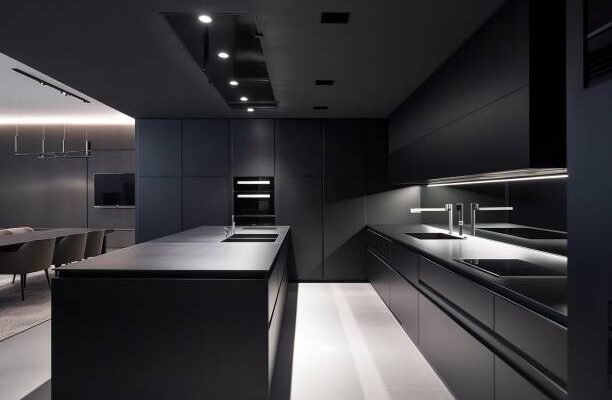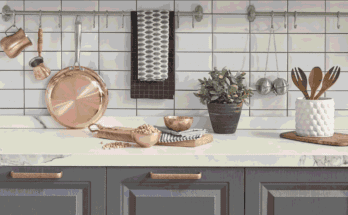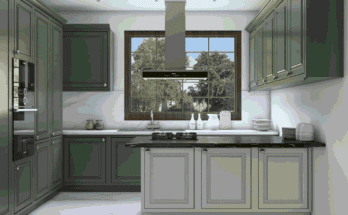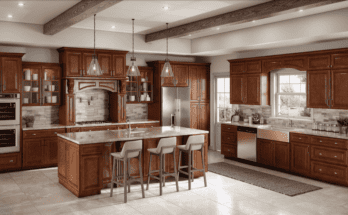1. Introduction
One has admired the effectiveness and prominently raw look that industrial kitchens have introduced to homeowners. Considering the architectural and technological appearance of factories and warehouses, the industrial style is raw-edged, combined with metal, wooden, and concrete accessories and sophisticated details.
In this article, we’ll learn how to arrange industrial design in kitchens and choose particular details, both the main and decorative ones, to create a unique and functional kitchen.
2. Core Elements of Industrial Kitchens
Exposed Brick Walls
Industrial-style kitchens are common with exposed brick walls – these walls massively add warmth and texture to the room and are an excellent background against modern metallic elements. Whether left in its natural colour or painted white, there is nothing like a touch of warm, enduring brick that requires very little maintenance.
Concrete and Stainless-Steel Surfaces
The design of concrete countertops and stainless steel appease the industrial contemporary style. Concrete also gives a matt finish and a rough to the touch while stainless steel is conspicuous, smooth and easy to clean. Both are quite durable and provide a sleek corporate look to any kitchen.
Open Shelving and Racks
Open shelves are historically associated with an industrial look making a kitchen look elegant and easy to access. Shelves and metal racks were added to the room to provide storage and organizational space as well as to provide quick access to plates and other commonly used items, the attractive dishware is also displayed.
Statement Lighting
Shop lighting can include pendant lights with a metal look, cage lighting or large bulb-type lighting fixtures which decorate the area and draw focus towards some portion of the kitchen. These statement fixtures work best as lighting but more importantly, they enhance the industrial theme.
Large Windows and Natural Light
Industrial kitchens all have large, exposed windows of large sizes that let in a lot of light and provide a great sensation of space. Especially, steel-framed windows perfectly match the factory theme providing an addition of luxurious motifs.
3. Industrial Kitchen Color Palettes
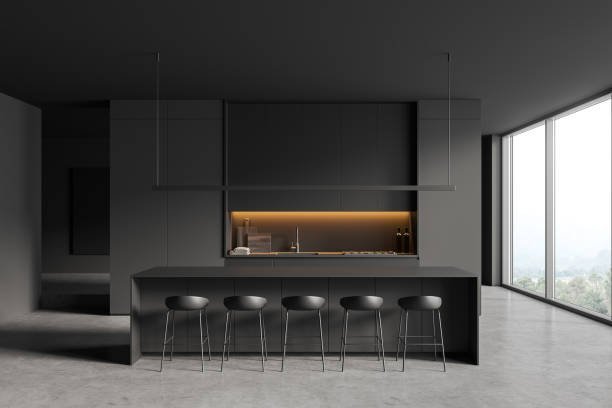
Neutral Tones and Monochromatic Schemes
Maintenance of the industrial look is common in modern industrial kitchens; they are mostly black, grey, beige, and container-like. These colors accentuate the use of natural elements such as the wooden floor and metal finishes complementing the raw look of the area.
Adding Subtle Pops of Color
To add personality, try to include some microgreens of the others using accessories like stools, rugs, or even a small kitchen appliance. The contrast colours associated with the industrial style, such as navy blue, forest green or burnt orange may be used to bring the contrast but the base should remain the same.
4. Essential Fixtures
Industrial-Style Faucets
Large and very utilitarian valve handles in contemporary matte black or brushed nickel are used as accent pieces. Especially, the pull-down faucets in the spring are to emulate the functionality of a professional kitchen with promoting the industrial style.
Vintage and Rustic Hardware
Bronze or brass knobs or handles on cabinets and drawers finish and complement other industrial items in an arrangement. These finishes give you contrasts and a touch of what I would refer to as postmodern designs.
Farmhouse Sinks
Old-fashioned farmhouse sinks whether in cast iron or pull-down stainless steel models are ideal for industrial use. These types of large and deep vessels will be perfect for a kitchen that needs to be very active and busy and fit perfectly into a hardworking aesthetic.
5. Appliances with an Industrial Edge
Choosing the Right Appliances
Modern industrial kitchens are equipped with all the necessary kitchenware and appliances of industrial standards. Choose the best ranges, ovens and refrigerators with a stainless steel exterior they will look good and be robust.
Integrated and Stainless-Steel Finishes
Integrating construction with stainless steel appliances is critical and one should consider having finishes that are built in. This choice improves the degree of industrial style and adds sophistication to the picture without upsetting the layout.
6. Flooring Options
Concrete Floors
Another benefit of concrete floors is that they are extremely hard-wearing and easy to clean and they also are representative of industrial interiors. They are also very flexible with their finish so you can have polished, stained or just raw lumber for a more natural look.
Hardwood with a Raw Finish
Pre-finished asphalt concrete, bare concrete and ground raw hardwood of low processing are warmer compared to metal and concrete. This mix of textures gives the place more character and stability as a home-kitchen kind of space.
Tile and Stone Alternatives
Brooklyn tiles or any tiles and stones having similar colours as the concrete can make the flooring stand out or blend with exposed brick walls which are usually used in industrial buildings giving texture and toughness to the floor.
7. Industrial Kitchen Layouts
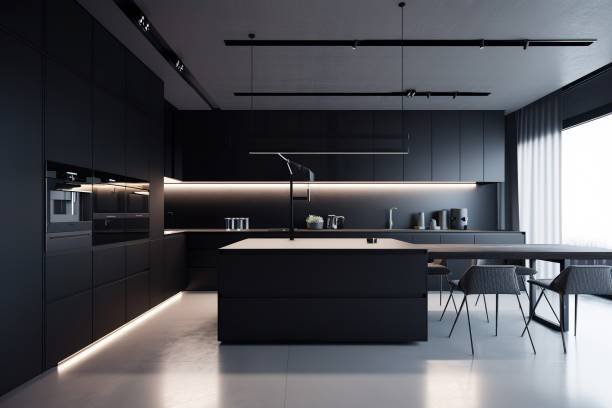
Open-Concept Layout
Industrial kitchens excel in the spaces where an open concept reigns supreme and heavyweight perspectives illustrate the idea. This arrangement also works well when the kitchen opens directly into the dining area which is common if the house is designed to host large gatherings and parties.
Island-Centric Design
Concrete or wooden kitchen islands perform the practical purposes of a kitchen and also become a focal point. It is suitable for reheating, preparing food and as an extra preparation area while being the epitome of an industrial look.
Work Triangle and Functional Flow
The industrial kitchen keeps function in mind, first of all, there should be an efficient triangle that connects the sink, stove and refrigerator. It also provides manoeuvrability and mobility which is crucial when food preparation areas are so active.
8. Decorative Accessories
Mixing in Vintage Decor
Industrial spaces call for accessories that were used in the first half of the twentieth century – metal bar stools, clocks or decoration pieces that have been salvaged. These details put character into the interior and at the same time help to emphasize the industrial theme without excessive domination.
Metal and Wood Accents
As for kitchen things, wooden cutting boards, metal pots and enchanting utensils not only fit perfectly to the overall design of the kitchen, enhancing its exterior but also can be effectively used.
9. Adding Plants and Greenery
Benefits of Indoor Plants in Industrial Spaces
Businesses introduce manpower and energy to an otherwise unyielding structure such as metal or concrete. This way they also increase air quality thereby making it much healthier.
Choosing Low-Maintenance Plants
For plants that do not need attention, the best choices include; succulents, snake plants, or pothos since they give a green touch without much attention.
10. Practical Storage Solutions
Cabinets and Open Shelving
Get the most space with a closed upper part of the furniture to have more closed compartments and open lower part of the furniture to have open shelves to show the items and ornaments used more frequently. It is a basic form of maintaining the balance in the kitchen and also its utility.
Storage for Industrial Cookware
Large sauté pans, forged cast iron pans for cooking bases or large stainless steel stock pots work well in an industrial kitchen setting. These items should be hung on hooks or racks for storage and beautification of the places as well.
11. Expert Insights
To capture an authentic industrial style, designer [Name of Expert] recommends combining raw materials with softer, textured elements like reclaimed wood or matte finishes. “Industrial kitchens should feel both functional and inviting,” says [Expert]. “The key is in balancing utility with warmth.”
12. Case Study
Among the latest transformations [Case Study Example] reveals how an old loft was redesigned into an attractive modern industrial kitchen with an open ceiling, concrete top table and a wooden vintage island. It shows how industrial furniture and designs can be fit to the style and practical needs of anyone, anywhere in the world.
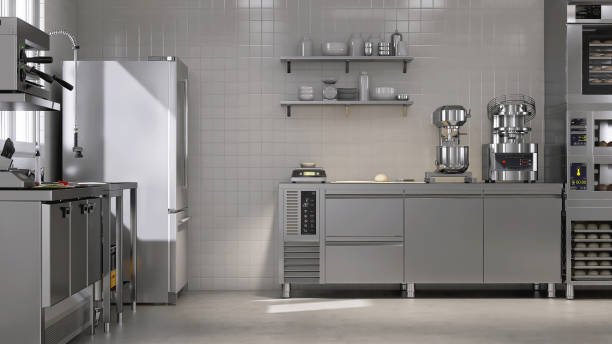
13. Future Trends in Industrial Kitchens
Sustainable Materials
‘Green’ is the new buzz word and designers are now using old wood, recycled metals and environmentally friendly concrete in industrial projects. These materials give personality and decrease the bore factor for the environment.
Smart Technology Integration
Smart technology, particularly smart ovens, lighting, and faucets is incorporated to optimise functionality while preserving the industrial feel. This trend equates elegance with the comfort of the twenty-first century.
14. Practical Applications
DIY Tips for Creating an Industrial Look
Make it industrial at a low cost using metal pipes as shelves or just using chalk paint to give cabinet woods that rugged look.
Budget-Friendly Ideas
Look for second-hand pieces in places like flea markets, do not need to add too many cabinets, and create big changes with just a few elements: lights or metal handles.
15. Conclusion
Industrial kitchens use heavy products complemented by beautiful touches making them practical, attractive, and warm. Adding industrial textures such as exposed brick, concrete walls and decorations with bold lighting will make you passionately decorate your home.
FAQ’s
[saswp_tiny_multiple_faq headline-0=”h3″ question-0=”1. What are the key elements of an industrial kitchen?” answer-0=”Industrial kitchens often feature exposed materials like brick walls, concrete countertops, and metal accents, along with open shelving, vintage decor, and statement lighting. ” image-0=”” headline-1=”h3″ question-1=”2. How do I make an industrial kitchen feel cozy?” answer-1=”You can add warmth to an industrial kitchen by incorporating wood accents, soft lighting, and plants. Adding textured materials like rugs or fabric cushions also helps balance the rugged look. ” image-1=”” headline-2=”h3″ question-2=”3. Are industrial kitchens high-maintenance?” answer-2=”Not necessarily. Many industrial elements, like concrete and stainless steel, are durable and easy to clean. However, exposed surfaces may need occasional upkeep to prevent wear. ” image-2=”” headline-3=”h3″ question-3=”4. Can I achieve an industrial look on a budget?” answer-3=”Yes, you can create an industrial style affordably by using reclaimed materials, DIY shelving with metal pipes, or shopping for vintage items at flea markets and thrift stores. ” image-3=”” headline-4=”h3″ question-4=”5. What colors work best in an industrial kitchen?” answer-4=”Neutral colors like black, gray, and beige work well, but subtle pops of color—like dark blue or green accents—can add personality without detracting from the industrial feel.” image-4=”” count=”5″ html=”true”]

